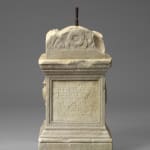*MARBLE FUNERARY ALTAR, Roman Empire, Flavian, 2nd half of 1st Century A.D.
marble
75.5 x 31 x 21 cm
29 3/4 x 12 1/4 x 8 1/4 in
Please note: this item is only for the Italian market
29 3/4 x 12 1/4 x 8 1/4 in
Please note: this item is only for the Italian market
Further images
Published A. Buonopane, La nuova testimonianza di un liberto imperiale a veste munda, Sylloge Epigraphica Barcinonensis (SEBarc) September 2021, pp. 167-177 Rectangular in shape, the front panel finely engraved within...
Published
A. Buonopane, La nuova testimonianza di un liberto imperiale a veste munda, Sylloge Epigraphica Barcinonensis (SEBarc) September 2021, pp. 167-177
Rectangular in shape, the front panel finely engraved within a recessed panel with eight lines of Latin inscription reading D(is) M(anibus) / Thesmi Caes / Nectareus Augl / A Veste Muna(m) / Alumno / Carissimo / Vix An (ni ) VI M(enses) VIIII / D(ies) III Hor(es) VII (Sacred to the Gods Mani / (dedicated to) Thesmus, slave of the emperor / (from) Nectareus imperial libertus (slave freed by the emperor himself ) / employee of the emperor's wardrobe / (dedicating therefore) to the dearest / apprentice / who lived 6 years, 8 months / 4 days and 7 hours).
The altar, therefore, was dedicated by Nectareus, an imperial freedman, who bears a personal name of Greek origin not very frequent in Rome, to the little Thesmus, a slave of the emperor, as indicated by the formula "Caesaris".
On the sides of the altar the symbols of ritual libations, the urceus and the patera, are carved in relief; a laurel wreath surrounded by floral decorations is sculpted on the tympanum.
The present artwork was thoroughly studied and published by Prof. Buonopane, a well-known epigraphist, who notes: “Nectareus, within the court, was assigned to a service that placed him in a fairly high position within the hierarchy of officiales Augustorum, immediately below the cubicularii, the emperor's room service staff, who in turn occupied a top position: in fact, Nactareus was responsible for taking care of the prince's wardrobe, which, as I mentioned earlier, indeed, it was quite complex and composed of dresses suitable for every occasion, public and private (...) munda was interpreted sometimes as «neat», sometimes as «propre», sometimes as «elegant». I believe that in this case the use of the adjective mundus with the meaning of "clean" should be discarded, as it is obvious that all the garments stored in the imperial wardrobe must have had this characteristic and that, instead, the adjective should refer to the particular type of dress, a simple dress, sober and without particular ornaments, perhaps used on particular occasions of an official nature.”
IMPORTANT NOTE: this item, marked with the symbol *, is located in Italy and an export license may not be granted.
A. Buonopane, La nuova testimonianza di un liberto imperiale a veste munda, Sylloge Epigraphica Barcinonensis (SEBarc) September 2021, pp. 167-177
Rectangular in shape, the front panel finely engraved within a recessed panel with eight lines of Latin inscription reading D(is) M(anibus) / Thesmi Caes / Nectareus Augl / A Veste Muna(m) / Alumno / Carissimo / Vix An (ni ) VI M(enses) VIIII / D(ies) III Hor(es) VII (Sacred to the Gods Mani / (dedicated to) Thesmus, slave of the emperor / (from) Nectareus imperial libertus (slave freed by the emperor himself ) / employee of the emperor's wardrobe / (dedicating therefore) to the dearest / apprentice / who lived 6 years, 8 months / 4 days and 7 hours).
The altar, therefore, was dedicated by Nectareus, an imperial freedman, who bears a personal name of Greek origin not very frequent in Rome, to the little Thesmus, a slave of the emperor, as indicated by the formula "Caesaris".
On the sides of the altar the symbols of ritual libations, the urceus and the patera, are carved in relief; a laurel wreath surrounded by floral decorations is sculpted on the tympanum.
The present artwork was thoroughly studied and published by Prof. Buonopane, a well-known epigraphist, who notes: “Nectareus, within the court, was assigned to a service that placed him in a fairly high position within the hierarchy of officiales Augustorum, immediately below the cubicularii, the emperor's room service staff, who in turn occupied a top position: in fact, Nactareus was responsible for taking care of the prince's wardrobe, which, as I mentioned earlier, indeed, it was quite complex and composed of dresses suitable for every occasion, public and private (...) munda was interpreted sometimes as «neat», sometimes as «propre», sometimes as «elegant». I believe that in this case the use of the adjective mundus with the meaning of "clean" should be discarded, as it is obvious that all the garments stored in the imperial wardrobe must have had this characteristic and that, instead, the adjective should refer to the particular type of dress, a simple dress, sober and without particular ornaments, perhaps used on particular occasions of an official nature.”
IMPORTANT NOTE: this item, marked with the symbol *, is located in Italy and an export license may not be granted.
Provenance
Private Collection, 1970s, Roma1
of
18














